The AMD Threadripper 2990WX 32-Core and 2950X 16-Core Review
by Dr. Ian Cutress on August 13, 2018 9:00 AM ESTHEDT Benchmarks: Office Tests
The Office test suite is designed to focus around more industry standard tests that focus on office workflows, system meetings, some synthetics, but we also bundle compiler performance in with this section. For users that have to evaluate hardware in general, these are usually the benchmarks that most consider.
PCMark 10: Industry Standard System Profiler
Futuremark, now known as UL, has developed benchmarks that have become industry standards for around two decades. The latest complete system test suite is PCMark 10, upgrading over PCMark 8 with updated tests and more OpenCL invested into use cases such as video streaming.
PCMark splits its scores into about 14 different areas, including application startup, web, spreadsheets, photo editing, rendering, video conferencing, and physics. We post all of these numbers in our benchmark database, Bench, however the key metric for the review is the overall score.
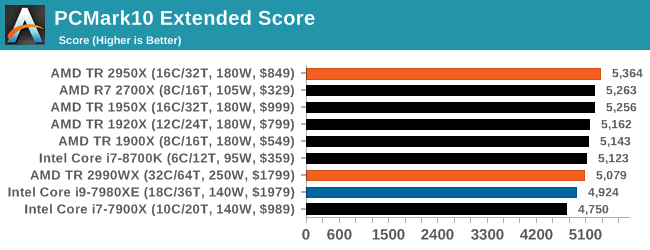
One of the downsides of PCMark is that it seems to bunch up all the results, showing them relatively close together, but interestingly here that the Intel processors sit near the bottom, with the 2950X and 2700X on the podium.
Chromium Compile: Windows VC++ Compile of Chrome 56
A large number of AnandTech readers are software engineers, looking at how the hardware they use performs. While compiling a Linux kernel is ‘standard’ for the reviewers who often compile, our test is a little more varied – we are using the windows instructions to compile Chrome, specifically a Chrome 56 build from March 2017, as that was when we built the test. Google quite handily gives instructions on how to compile with Windows, along with a 400k file download for the repo.
In our test, using Google’s instructions, we use the MSVC compiler and ninja developer tools to manage the compile. As you may expect, the benchmark is variably threaded, with a mix of DRAM requirements that benefit from faster caches. Data procured in our test is the time taken for the compile, which we convert into compiles per day.
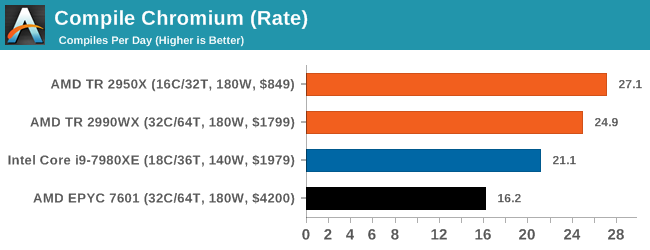
This test is such a nice mix of ST, MT, and memory limited flow that it is really interesting to see where the results end up. Unfortunately for our new suite the output files were not set up correctly, so despite running the test we only ever got a handful of results. But it shows an interesting metric: the 2950X sits ahead of the 2990WX, with both ahead of the Core i9, and the EPYC system being beaten handily due to its lower frequencies.
3DMark Physics: In-Game Physics Compute
Alongside PCMark is 3DMark, Futuremark’s (UL’s) gaming test suite. Each gaming tests consists of one or two GPU heavy scenes, along with a physics test that is indicative of when the test was written and the platform it is aimed at. The main overriding tests, in order of complexity, are Ice Storm, Cloud Gate, Sky Diver, Fire Strike, and Time Spy.
Some of the subtests offer variants, such as Ice Storm Unlimited, which is aimed at mobile platforms with an off-screen rendering, or Fire Strike Ultra which is aimed at high-end 4K systems with lots of the added features turned on. Time Spy also currently has an AVX-512 mode (which we may be using in the future).
For our tests, we report in Bench the results from every physics test, but for the sake of the review we keep it to the most demanding of each scene: Ice Storm Unlimited, Cloud Gate, Sky Diver, Fire Strike Ultra, and Time Spy.

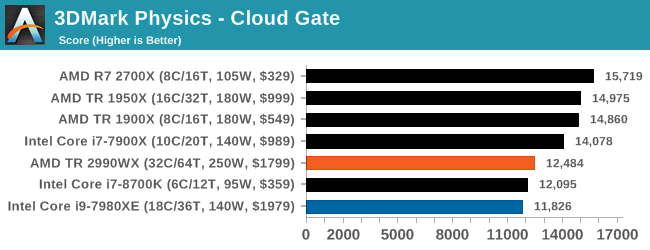

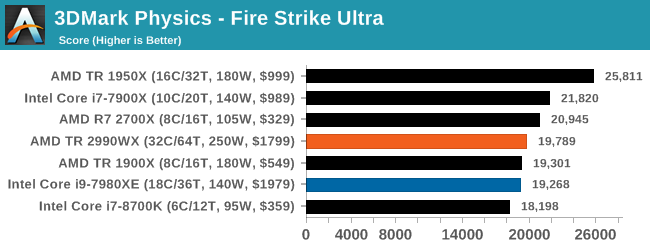
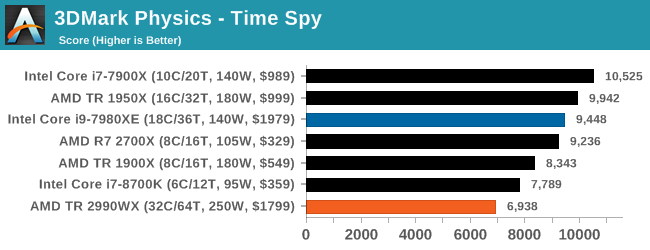
In the low end tests, it is clear that having these big processors doesn’t do much for performance, but even as we go up through Fire Strike and Time Spy, there seems to be a natural limit to the usefulness of these parts. Physics clearly loves having some extra memory bandwidth, and we know Time Spy isn’t meant to scale beyond about 10 cores, but we do see the 10 core processor sitting out front. Some of our testing sweeps had this benchmark configured incorrectly so it will be interesting to see how it fills out with some other mid and high core count processors.
GeekBench4: Synthetics
A common tool for cross-platform testing between mobile, PC, and Mac, GeekBench 4 is an ultimate exercise in synthetic testing across a range of algorithms looking for peak throughput. Tests include encryption, compression, fast fourier transform, memory operations, n-body physics, matrix operations, histogram manipulation, and HTML parsing.
I’m including this test due to popular demand, although the results do come across as overly synthetic, and a lot of users often put a lot of weight behind the test due to the fact that it is compiled across different platforms (although with different compilers).
We record the main subtest scores (Crypto, Integer, Floating Point, Memory) in our benchmark database, but for the review we post the overall single and multi-threaded results.












171 Comments
View All Comments
just4U - Monday, August 13, 2018 - link
Ian, were you testing this with the CM Wraith Cooler? If not is it something you plan to review?Ian Cutress - Monday, August 13, 2018 - link
Most of the testing data is with the Liqtech 240 liquid cooler, rated at 500W. I do have data taken with the Wraith Ripper, and I'll be putting some of that data out when this is wrapped up.IGTrading - Monday, August 13, 2018 - link
To be honest, with the top of the line 32core model, it is interesting to identify as many positive effect cases as possible, to see if that entire set of applications that truly benefit of the added cores will persuade power users to purchase it.Like you've said, it is a niche of a niche and seeing it be X% faster of Y% slower is not as interesting as seeing what it can actually do when it is used efficiently and if this this makes a compelling argument for power users.
PixyMisa - Tuesday, August 14, 2018 - link
Phoronix found that a few tests ran much faster on Linux - for 7zip compression in particular, 140% faster (as in, 2.4x). Some of these benchmarks could improve a lot with some tweaking to the Windows scheduler.phoenix_rizzen - Wednesday, August 15, 2018 - link
It'd be interesting to redo these tests on a monthly basis after Windows/BIOS updates are done, to see how performance changes over time as the Windows side of things is tweaked to support the new NUMA setup for TR2.At the very least, a follow-up benchmark run in 6 months would be nice.
Kevin G - Monday, August 13, 2018 - link
Chiplets!The power consumption figures are interesting but TR does have to manage one thing that the high end desktop chips from Intel don't: off-die traffic. The amount of power to move data off die is significantly higher than moving it around on-die. Even in that context, TR's energy consumption for just the fabric seems high. When only threads are loaded, they should only be with dies with the memory controllers leaving two dies idle. It doesn't appear that the fabric is powering down while those remote dies are also powering down. Any means of watching cores enter/exit sleep states in real time?
I'd also be fun to see with Windows Server what happens when all the cores on a die are unplugged from the system. Consdiering the AMD puts the home agent on the memory controller on each die, even without cores or memory attached, chances are that the home agent is still alive consuming power. It'd be interesting to see what happens on Sky Lake-SP as well if the home agents on the grid eventually power themselves down when there is nothing directly connected to them. It'd be worth comparing to the power consumption when a core is disabled in BIOS/EFI.
I also feel that this would be a good introduction for what is coming down the road with server chips and may reach the high end consumer products: chiplets. This would permit the removal of the off-die Infinity Links for something that is effectively on-die throughout the cluster of dies. That alone will save AMD several watts. The other thing about chiplets is that it would greatly simplify Thread Ripper: only two memory controller chiplets would be to be in the package vs. four as we have now. That should save AMD lots of power. (And for those reading this comment, yes, Intel has chiplet plans as well.). The other thing AMD could do is address how their cache coherency protocols work. AMD has hinted at some caching changes for Zen 2 but lacks specificity.
gagegfg - Monday, August 13, 2018 - link
do not seem to exist more than once the 16 additional core of the 2990wx compared to the 2950xIan Cutress - Monday, August 13, 2018 - link
https://www.anandtech.com/bench/product/2133?vs=21...Chaitanya - Monday, August 13, 2018 - link
Built for scientific workload.woozle341 - Monday, August 13, 2018 - link
Do you think the lack of AVX512 is an issue? I might build a workstation soon for data processing with R and Python for some Fortran models and post-processing. Skylake-X looks pretty good wit its quad memory channels despite its high price.